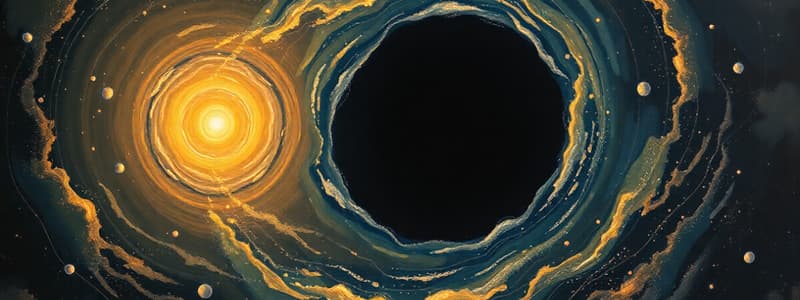Podcast
Questions and Answers
सूर्य के प्रकाश को पृथ्वी तक पहुँचने में कितना समय लगता है?
सूर्य के प्रकाश को पृथ्वी तक पहुँचने में कितना समय लगता है?
- 10 मिनट
- 12 मिनट
- 15 मिनट
- 8 मिनट 20 सेकंड (correct)
चन्द्रमा किस प्रकार से पृथ्वी पर प्रभाव डालता है?
चन्द्रमा किस प्रकार से पृथ्वी पर प्रभाव डालता है?
- चन्द्रमा पृथ्वी के घूर्णन को धीमा करता है
- चन्द्रमा पृथ्वी पर किसी प्रकार का प्रभाव नहीं डालता है
- चन्द्रमा पृथ्वी को अपनी ओर खींचता है, जिससे ज्वार-भाटा आता है (correct)
- चन्द्रमा पृथ्वी पर प्रकाश डालता है, जिससे दिन और रात होते हैं
अरुण ग्रह को हश ग्रह क्यों कहा जाता है?
अरुण ग्रह को हश ग्रह क्यों कहा जाता है?
- क्योंकि यह सौर मंडल के सभी ग्रहों से सबसे बड़ा है
- क्योंकि यह अन्य ग्रहों के मुकाबले ज्यादा ठंडा है
- क्योंकि यह अपने अक्ष पर क्षैतिज रूप से 97 डिग्री झुका हुआ है (correct)
- क्योंकि यह सूर्य से सबसे दूर है
सौर मंडल की गति किस गति से आकाशगंगा का चक्कर लगाती है?
सौर मंडल की गति किस गति से आकाशगंगा का चक्कर लगाती है?
सौर मंडल कितने समय में आकाशगंगा का एक चक्कर पूरा करता है?
सौर मंडल कितने समय में आकाशगंगा का एक चक्कर पूरा करता है?
निम्नलिखित में से कौन सा कथन वरुण ग्रह के बारे में सही नहीं है?
निम्नलिखित में से कौन सा कथन वरुण ग्रह के बारे में सही नहीं है?
सूर्य और पृथ्वी के बीच की दूरी को क्या कहते हैं?
सूर्य और पृथ्वी के बीच की दूरी को क्या कहते हैं?
पृथ्वी व सूर्य के बीच की सबसे अधिकतम दूरी कितनी होती है?
पृथ्वी व सूर्य के बीच की सबसे अधिकतम दूरी कितनी होती है?
आपको किन ग्रहों को नग्न आंखों से देखा जा सकता है?
आपको किन ग्रहों को नग्न आंखों से देखा जा सकता है?
कौन सा ग्रह सौरमंडल का इकलौता ऐसा ग्रह है जिसका घूर्णन समय उसके परिक्रमण समय से ज़्यादा है?
कौन सा ग्रह सौरमंडल का इकलौता ऐसा ग्रह है जिसका घूर्णन समय उसके परिक्रमण समय से ज़्यादा है?
Flashcards
कृष्ण विवर
कृष्ण विवर
वह ब्रहमांड का भाग जहाँ ग्रैविटी इतनी अधिक होती है कि प्रकाश बाहर नहीं आ सकता।
सूर्य
सूर्य
यह एक तारा है, जो पृथ्वी का सबसे निकटतम तारा है और इसका व्यास 14 लाख किमी है।
चक्र प्रक्रिया
चक्र प्रक्रिया
यह प्रक्रिया है जिसमें पृथ्वी सूर्य के चारों ओर चक्कर लगाती है, और चंद्रमा पृथ्वी के चारों ओर।
अप - भू
अप - भू
Signup and view all the flashcards
सूर्य ग्रहण
सूर्य ग्रहण
Signup and view all the flashcards
वरुण ग्रह
वरुण ग्रह
Signup and view all the flashcards
घूर्णन समय
घूर्णन समय
Signup and view all the flashcards
परिकर्मण समय
परिकर्मण समय
Signup and view all the flashcards
खगोलीय इकाई
खगोलीय इकाई
Signup and view all the flashcards
अपसौर
अपसौर
Signup and view all the flashcards
Study Notes
GEOGRAPHY NOTES
- Black Holes: Gravity pulls everything, even light, into a black hole. Light never escapes.
- Event Horizon: The boundary around a black hole where gravity is so strong, even light can't escape.
- Milky Way Galaxy: Our galaxy has a spiral structure with a bulge in the center. It contains stars, planets, and other celestial objects.
- Solar System: The Sun and the objects that orbit it, including the Earth. The Sun is the star at the center.
- Sun (सूर्य): A star at the center of our solar system. It's a huge ball of gas that produces light and heat energy through nuclear fusion.
- Diameter: Approximately 1.4 million kilometers.
- Age: About 4.6 billion years.
- Composition: Primarily hydrogen (71%) and helium (26.5%).
- Light travel time: Takes about 8 minutes for sunlight to reach Earth.
- Gravity: Much stronger than Earth's gravity.
- Constellations (तारामंडल): Groups of stars that appear to form patterns in the night sky.
- Stars (तारे): Huge balls of gas that produce light and heat through nuclear fusion. The Sun is a star.
- Cycles (चक्र):
- Lunar Cycles (चन्द्रमा के चक्र): The moon follows a cycle that includes phases like new moon, first quarter, full moon, and third quarter.
- Solar Eclipse (सूर्य ग्रहण): When the moon passes between the Earth and the Sun, blocking some or all of the sunlight.
- Lunar Eclipse (चन्द्र ग्रहण): When the Earth passes between the Sun and the Moon, casting a shadow on the Moon.
- Planets (ग्रह): Large celestial bodies that orbit a star and shine by reflected light.
- Moons (चन्द्रमा): Celestial bodies that orbit a planet.
- Asteroids (क्षुद्रग्रह): Small rocky bodies that orbit a star.
- Comets (धूमकेतु): Icy bodies that orbit a star and may have a tail.
PLANETS AND THEIR PROPERTIES
- Planets table: Includes information about planets like Mercury, Venus, Earth, Mars, Jupiter, Saturn, Uranus, and Neptune. Provides data about rotation time, revolution time, and additional details.
ADDITIONAL INFORMATION
- Aphelion (अपसौर): The point in a planet's orbit farthest from the sun.
- Perihelion (उपसौर): The point in a planet's orbit closest to the sun.
- Astronomy (खगोल विज्ञान): The study of celestial objects and phenomena in the universe.
- Celestial Objects (आकाशीय पिंड): Objects in space like planets, stars, and galaxies.
- Constellations (तारामंडल): Patterns of stars.
- Galaxies (आकाशगंगा): Vast collections of stars, gas, and dust.
- Solar System (सौर मंडल): The system of planets and other objects that orbit the Sun.
- Stars (तारे): The Sun is a star.
Studying That Suits You
Use AI to generate personalized quizzes and flashcards to suit your learning preferences.





